*Update: a long overdue post...for some reason (maybe summer and storms got in the way) I have been procrastinating on finishing this piece. It's rainy, it's cold, it's done....*
It's summer and solanaceae rule the day. This family of plants are at home with heat and we here in the north tend to spend much of our season catering to their every whim and need. Too much water? too little water? needs covering? needs pollinating? needs trellising? Out of all of them, I would say eggplant is the fussiest. OP and heirloom eggplants in particular get a bad rap for being highly dependent on the perfect season and the utmost in care to even have a decent harvest. Enter my new favorite heirloom:
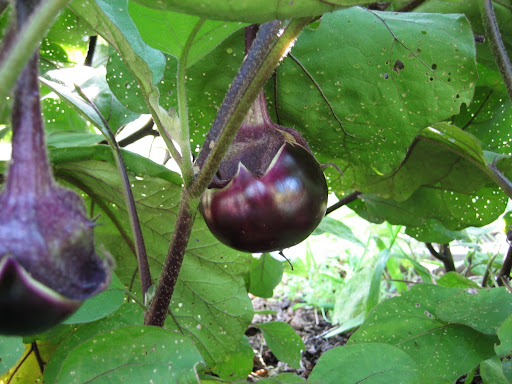
Kamo (
Kitazawa Seed Co.) is a Japanese heirloom eggplant originating in the Kyoto region. Apparently it is highly prized in Japan for its sweet flavor and smooth texture (it's also cute as a button). When I harvested the first one, the weight gave it away. Full sized at four inches across, this diminutive specimen was easily the weight of a full sized "American" eggplant. I fried it up to sample this new-to-me variety and holy moly, what yumminess exuded from each bite. I should eat so well every day. It has produced just as well as the two hybrids I am growing and might actually out pace them as the season progresses. If I really had to say one not so great thing, it would be that the leaf cover is pretty dense and the shaded eggplants don't get as beautifully dark and shiny. Also I have seen a couple of split ones, which are still usable (they don't rot like tomatoes do) but they aren't pretty.

OK, I am growing about 10 different heirloom tomatoes, and everyone's got their favorite. So I am just going to do one variety and then get on with it. This one, Cour di Bue (
Baker Creek), is new to me. It is pretty aptly named, I actually get a little creeped out when I harvest these. It's almost like plucking an anatomical heart out of a tomato plant chest. You need to find the perfect ripeness for these, overripe is not so great, but the taste is excellent, a little sweet, a little acidic and very tomatoey. The plants have done pretty well for themselves, not the weakest, not the hardiest, we'll see how long they last into the fall. Oh, by the way, Baker Creek classifies them as a red tomato. In my eyes they are most certainly pink...
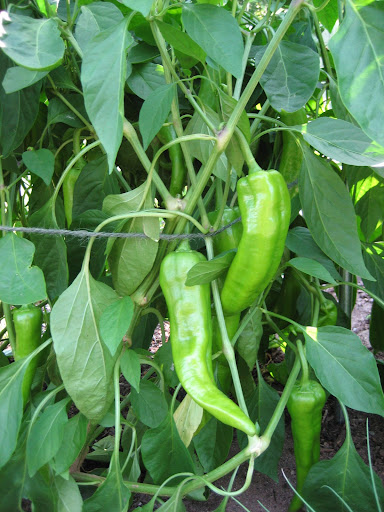
I was lying before. Kamo is not my favorite. Although this doesn't classify as an heirloom
yet, I hope that someday it will. Bridge to Paris (
Hudson Valley Seed Library) is just about the most perfect pepper. It also has the distinction of being born at a farm I used to work at. Although I didn't begin to de-hybridize the original La Paris, I took on the legacy and raised it every year in its own patch so we could confidently save the seed. I also tried to take out most of the rogue "hotties" that showed up in the gene pool every once and a while, but I hear there are still a few out there. This pepper is productive, has few sunscalded peppers because of its heavy leaf cover (as long as you support it to keep the plant upright) and the drier flesh is perfect for roasting, frying, etc. It is best when it is candy apple red and I think it is far tastier that most bell peppers.
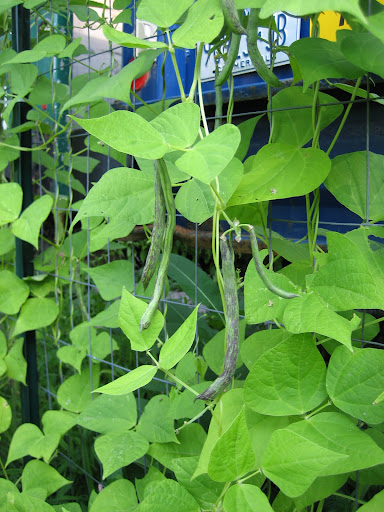
Rattlesnake Pole Bean (
High Mowing): I know this is a favorite of a farmer friend of mine, so I decided to grow it this year. I have not been disappointed. Early, productive, vigorous vines. I only wish I had another 10' of fence for it to climb up. It seems to produce in very strong flushes, so far it is on its second one...will it make a third? They do develop strings on the pods when they get to be about 6 inches long, so watch out for those when cooking. Also the purple stripes disappear completely, but the beans themselves do turn a very pleasing bright green. Beany tasting, but not dry, I bet it would be perfect for a revamped green bean casserole or a bean salad.
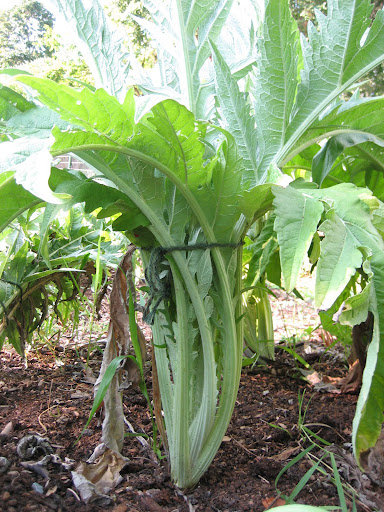
Gobbo Di Nizzia Cardoon (
Baker Creek): I've never eaten a cardoon, I've never grown a cardoon (until now) and I've only seen them once, at a market in California. So this was truly a new experience for me. It looked good in the middle of winter as I was snuggled up with all the seed catalogs. I pictured early September (when this will be harvested) and its perfect crisp days and I thought, why the heck not? Well, it's almost time and it looks good...but I'm not quite sure when to pick it or what it should taste like. But it does look good.
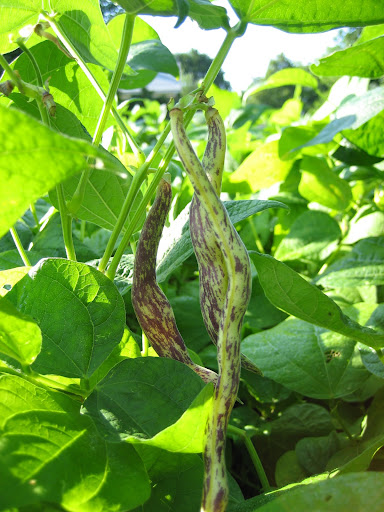
Dragon's Tongue Beans or Dragon Langerie Beans (
Hudson Valley Seed Library and
High Mowing): I actually took a couple of packets of seeds from both these companies and put them together, so I can't quite tell you if the two seed populations differ from each other, but I have to say they are doing great overall. But hey, this variety has been part of my growing plan since 2008, so that's no surprise. I was surprised though, by how big the beans got this year. I swear I was pulling out 8" beans that were still tender and snappy! Anyways, yes, this is a pretty bean, but it is also quite productive and tasty as well. Again, be aware that those lovely purple stripes don't make it through cooking, but eaten raw with a creamy dip, they are pretty fabulous.
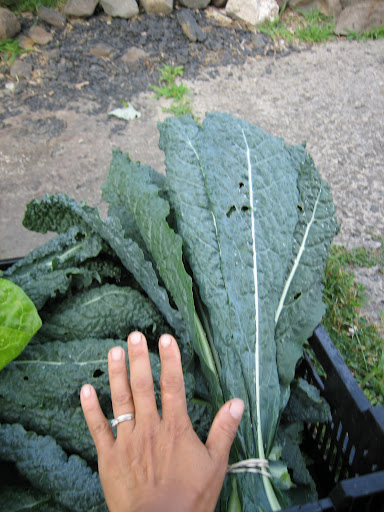
Dinokale (
HV Seed Library) is also known as Tuscan kale or lacinato kale or many other variously intriguing names. I have grown it for many years from different seed suppliers and I have to say that the Seed Library's strain is the best, hands down (hence the photo). I don't know if it is the growing conditions here or if these seeds are somehow super bred, but I have had just one planting all year and it has consistently yielded leaves as long as my arm. Not just my forearm...my whole arm! The plants are about 3 feet tall now and really do resemble northern palm trees. I might just get a full season down to winter with these babies. Oh, and besides that, they are tender and cook up a midnight green. I often like it better than the normal curly varieties. I cannot recommend the HVSL strain enough, I never knew Dinokale could be so awesome!

Clemson Spineless (
HV Seed Library): Another one from the Seed Library. For a while my go-to variety for okra was Cajun Delight, a hybrid that was part of the transfer to Monsanto after they bought Seminis. So since then I have grown a few different varieties, and this year it was Clemson's turn. So far the results have been mixed. It's still a beautiful plant and I would grow it just for that, but the yield has been so-so. Granted okra really is a southern plant and had I lived in Georgia, I would have at least twenty different varieties to chose from, all producing exasperatingly large quantities, but still, it'd be nice to have more branching and therefore more yield potential. For the most part these guys have stayed with one stalk producing a pod every other day. It's a good thing okra's not a hugely popular item. As for taste, etc.: it's fine, though I wish the pods stayed tender when they were just a little bit bigger. They seem to be perfect at right around 3 inches.

Bonus photo: I've been doing my best to put up jars for the out-of-town
Kickstarter contributors. I hope some of them like pickled okra ;) The other jars are cucumber spears, dilly wax beans, dilly romano beans, sunshine squash (a sweet pickle) and maple vanilla peach jam. Not shown are the jalepeno jelly and the eggplant-tomato relish (kind of like caponata, but less caper-y).
No comments:
Post a Comment